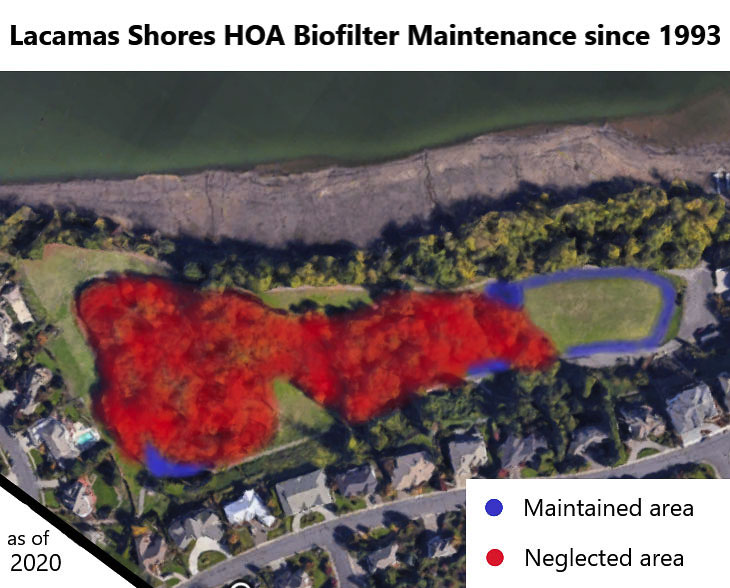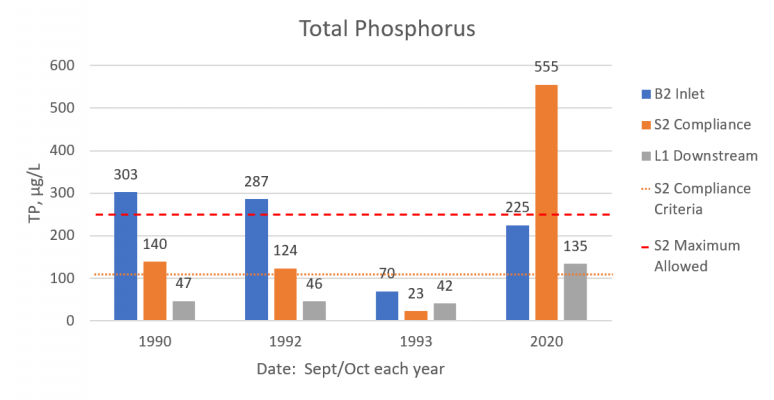Failed biofilter is the only known source of pollution contributing to poor lake water quality
Steve Bang’s patience has finally run out. After seven years of discussions with the Lacamas Shores Homeowners Association (LSHOA), city of Camas staff, council members, and state representatives and agencies, Bang’s attorneys at Plauché & Carr LLP sent a notice of intent to sue for violating federal clean water standards.
The past three years have seen increasing toxic algae blooms in Lacamas, Round, and Hidden Leaf lakes. Late last week, the Clark County Public Health Department issued another public health warning regarding toxic algae at Lacamas and Round lakes due to a reading of toxins three times higher than any recorded test for either lake.
Bang has filed a citizen’s action to sue his own HOA and the city of Camas for violating the Clean Water Act (CWA). Congress deems clean water so important that it specifically authorized citizens to file suit when the government fails to stop water pollution.
His lawsuit states the following.
“The HOA and the City have violated and are violating 33 U.S.C. § 1311 and 33 U.S.C. § 1342 by discharging pollutants from the Lacamas Shores biofilter treatment facility (“Biofilter”), located on Clark County Tax Lot 84839000, into Lacamas Lake and its adjoining wetlands without a discharge permit. These violations have occurred since at least September 23, 2020 and are ongoing.”

“Someone has to do something, and right now the Lacamas Shores biofilter facility is the only currently known and controllable source of pollution,” Bang said.
Last fall, a group of citizens spent their own time and money to test both input and output water quality at multiple locations of the LSHOA biofilter. Instead of cleaning the stormwater, the biofilter was adding pollutants to the water, the results revealed.
Marie Callerame was an integral part of the citizen effort to collect the data. She compiled an extremely thorough report she provided to both the city and the LSHOA in February. All the information she has compiled is posted on this website.
In 2020, Lacamas Lake tested positive for harmful algae toxins 26 out of 29 times between April and October according to Callerame. The website summarizes the results of the report, stating:
“Surprisingly, the stormwater coming into the biofilter is the same or cleaner than it was during the same time of year in the early 1990’s. Unfortunately, unlike the early 90’s, the biofilter is not filtering out the phosphorus or suspended solids. Instead, it is adding the pollutants it collected throughout the past 20+ years back into the water and into the lake.”
Under the Federal Clean Water Act, the fines can be significant, but once collected they do not go to the citizen. The CWA does allow for the citizen (Bang) to be reimbursed for his attorney’s fees,.although the initial outlay of those expenses can be very high. This is a built-in deterrent to frivolous citizen lawsuits.
Leslie Lewallen, an attorney and candidate for Camas City Council, shared the following on social media.
“In a short 60 days, the City of Camas could be on the hook for federal fines as much as $326,000 a day for ignoring known pollutants that are seeping into Lacamas Lake. Let that sink in. That’s $9.9 million dollars a month in fines our city will have to pay- because a private HOA has failed to maintain its biofilter and the city is part of the reason why.”
In July 2017, the LSHOA gave a proposal to the city of Camas. They wanted to perform maintenance on the biofilter. “We would like to return parts of the system to a healthy well-vegetated widespread wetland buffer habitat with grasses, and other wetland plants for proper bio-filtration.” Expected costs for their proposal was about $30,000.
In Feb. 2018, the Camas city attorney wrote the LSHOA. He claimed the biofilter was a “wetland” rather than a biofilter. But later stated the LSHOA stormwater facility should do three things.
- Be capable of accepting the stormwater coming into it from its intake;
- Effectively treat the stormwater; and
- Provide for appropriate outfalls of treated stormwater.
He then demanded a “conditional use permit be obtained” by the HOA.

A month later, a staff member of the Washington State Department of Ecology sent a letter to the city. It stated: “I have found no evidence to show that the wetland was constructed . . . for the purpose of stormwater treatment or detention.” They said they were “unlikely to approve a conditional use permit”.
“This was unbelievable,” said Bang earlier this year. HOA bylaws state there is a biofilter that must be maintained. “The deed to my property obligates each and every homeowner to maintain the biofilter and stormwater system. The Washington Shoreline Hearings Board mandated the biofilter be created as part of the original development permit. They must have not been looking,” he said.
The city apparently forbade the LSHOA from repairing their biofilter, based upon the DOE letter.
In 2020, to many residents, it seemed like there was almost no time there weren’t “caution” or “warning” signs displayed around the lake. Reported testing results indicated toxic algae blooms occurred over a dozen times. Various “toxins” exceeded state guidelines multiple times during the year. Microcyctin exceeded state guidelines 14 times and anatoxin exceeded guidelines once.
Callerame is one of seven Camas citizens on a special board the City Council created to provide input on cleaning up the lake water. Last week she reported the following.
“Ecology’s website just populated this morning with a sample collected 8/9. The result for microcystin is higher than it has EVER been recorded in our lakes – 3 times higher than the highest reading! It measured as 261 µg/L. This is over 40 times the state guideline of 6 µg/L, well over dog-kill level.”
The City Council allocated $300,000 in their two-year budget for lake water quality issues. It spent $106,400 for a consultant to further study lake water quality issues. It also received $215,000 in grants. The council members expect a report next spring.
Randal Friedman is a Camas resident who worked on a variety of environmental issues for 32 years as a civilian serving the Navy. He heard about the possible lawsuit regarding CWA violations. “I can assure you this is not a delicate tool,” he said.
He hopes the city and the HOA take the threat seriously. He believes it is also a question of leadership.
“If Camas wants the county and state to ratchet up the regulation of other private (and public) lands in the Lacamas Lake watershed, they better start in their own backyard,” he said.
Bang indicated he will file the lawsuit in 60 days, unless they solve the problem first. The notice and all the relevant information can be found here.




